Low FODMAP Pad Thai
Noodles are such a perfect comfort food. They are fun to eat – any day I get to slurp is a good day. But noodles doesn’t just have to mean red sauce.
Needing Noodles?
I love Pad Thai and you seriously do not have to wait to go to a restaurant to eat it. And now you can enjoy your very own Low FODMAP version!
In fact, because most Thai restaurants would be hard pressed to make this for you without garlic or the white parts of scallions, it is even better if you try our version.
It’s All About Balance
We sometimes make it with shrimp, other times with cubed and sautéed tofu and sometimes both! We make it a little different every time in terms of seasoning.
Let me explain…
Pad Thai is a delicate balance between the salty fish sauce, tart lime juice, sugar, sweet and tart ketchup (that’s right, ketchup! More on that later), fresh herbaceous cilantro, oniony scallion greens, watery crunchy bean sprouts, salty crunchy peanuts and hot spicy red pepper flakes.
What makes the dish so iconic and delicious is the balance of all of these ingredients that treat your palate to all of these flavors as well as hot and cold temperatures.
We think the equilibrium of the fish sauce, lime juice, sugar and pepper flakes are particularly important and their balance can make or break this dish. While we do provide amounts below, don’t be afraid of tasting and adjusting as needed.
One caveat: do not just taste the sauce on its own as it is hard to assess at that point. Taste once it is incorporated into the noodles and add a little more of whatever you need to balance it out.
Back to the Ketchup
Now, maybe you haven’t used ketchup as an ingredient before but it is a seasoned tomato product that gives us a shortcut. It is often found in versions of Pad Thai sauce and put to great use here.
Just be sure to follow the guidelines in the Monash App about the amount of Ketchup you can safely eat- basically under 2 teaspoons or 13 grams. FODY Foods has made it really easy for you with their low FODMAP Ketchup. And even Heinz has made a version you can try.
Some recipes for Pad Thai use tamarind paste, which provides body, reddish color and a sweet/tart flavor – and tamarind is low FODMAP – but we wanted to give you a recipe made with more easily found ingredients.
Fish sauce used to be a specialty product but can now be found in most well stocked supermarkets. We use Red Boat Premium brand in the Test Kitchen – it’s gluten-free, no MSG and preservative free – also shellfish free.
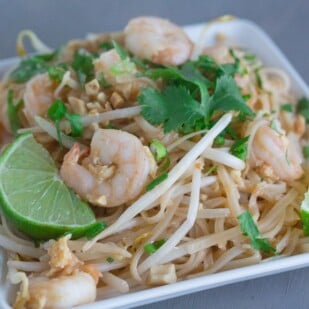
Low FODMAP Pad Thai
Make this Pad Thai at home and stay within your low FODMAP diet needs while satisfying your noodle cravings.
Ingredients:
Noodles:
- 10 ounces (280 g) medium sized rice stick noodles, 1/4-inch (6 mm) thickness
Garnishes:
- 1/4 cup (4 g) roughly chopped cilantro
- 1/4 cup (37 g) chopped dry-roasted peanuts
- 1/4 cup (16 g) chopped scallions, green parts only
- 2 limes, cut into wedges and 1 tablespoon lime juice squeezed, ready to use and set aside
Sauce:
- 1/3 cup (75 ml) fish sauce
- 1/4 cup (60 ml) ketchup, with no HFCS (high fructose corn syrup)
- 3 tablespoons water
- 1 1/2 tablespoons sugar
- 1 tablespoon lime juice, reserved from above
- 1/4 teaspoon to ½ teaspoon chilli powder, ground red serrano chiles
- 1/4 cup (60 ml) Low FODMAP Garlic-Infused Oil, made with vegetable oil, or purchased equivalent, divided
- 1 pound (455 g) large shrimp (26 to 30 count), defrosted and peeled
- 4 large eggs, lightly beaten
- 3 cups (312 g) mung bean sprouts, divided
Preparation:
-
For the Noodles: Place the rice stick noodles in a large, deep bowl and cover with the hottest tap water and allow to sit and soften. They need about a 6 to 8 minute soak.
-
For the Garnishes: Have all of the garnishes ready to use. One of the limes should be squeezed, as you will need 1 tablespoon of lime juice for the next step.
-
For the Sauce: Whisk together the fish sauce, ketchup, water, sugar, lime juice and red pepper flake around in the oils (amount as desired) in a small bowl; set aside.
-
Heat 1 tablespoon oil in a wok or other large, deep-sided skillet until shimmering over medium-high heat. Add shrimp, stir-fry quickly just until pink, about 1 to 2 minutes, then remove and set aside.
-
Test the noodles; they should be pliable. Drain in a colander and shake off excess water.
-
Add remaining oil to wok and heat until shimmering over medium-high heat. Add eggs and leave them undisturbed for about 15 to 30 seconds to begin to set, then stir fry them around until about three-quarters of the way cooked through; they should still be moist. Add the sauce and the noodles and stir fry to coat with sauce and until the noodles are tender, about 2 to 3 minutes.
-
Add the shrimp and half of the bean sprouts and stir fry to incorporate into the noodles and sauce and to reheat shrimp.
-
Divide onto plates quickly and immediately top with remaining bean sprouts, cilantro, peanuts and scallions and serve with lime wedges.
Notes:
If You Can Tolerate
Fructans:
- If you have passed the garlic fructan Challenge, add 2 minced garlic cloves to the hot oil right before the eggs. Simply stir the garlic around in the oil for about 10 seconds before adding the eggs.
- If you have passed the onion fructan Challenge, feel free to use the white parts of the scallions as well.
Nutrition
All nutritional information is based on third-party calculations and should be considered estimates. Actual nutritional content will vary with brands used, measuring methods, portion sizes and more. For a more detailed explanation, please read our article Understanding The Nutrition Panel Within Our Recipes.
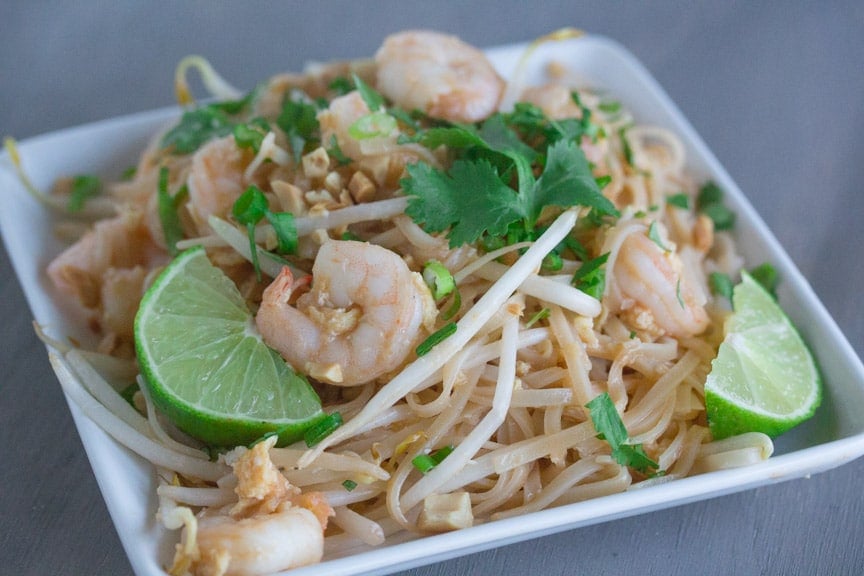
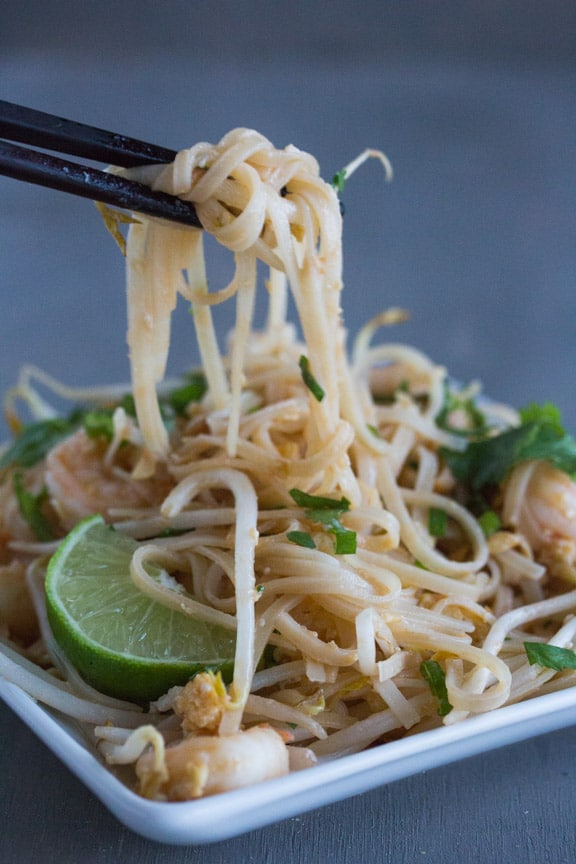
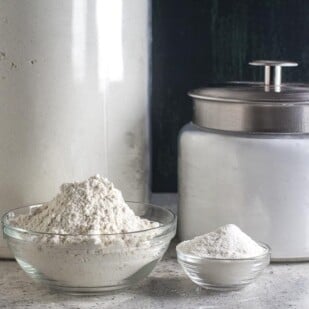
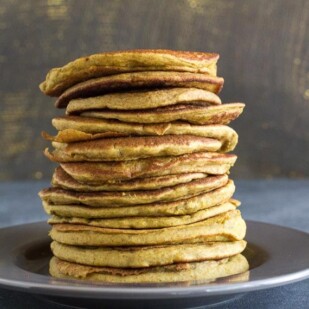






I made more sauce than necessary, will it keep in a sealed jar in the fridge ?
I have never tried but I would say use within the week. Thank you for writing and asking! Hope you enjoyed the recipe.
I keep my extra sauce in the fridge all the time and use it on rice or fresh rice noodles later in the week. I’ve used it usually within 4 days, so I’m not sure how long past that it would keep.
It is a pretty sturdy sauce and we too have kept it for days, well covered, in the fridge. Makes dinner-making easy! Or lunch for that matter. I’ll just dip tofu in it as a snack. Or even veggies.
I’ve altered this recipe in a couple different ways. The amount of fish sauce was way too much for me, so I use about 2 tablespoons. I also added some Adam’s Chunky Peanut Butter to the sauce to thicken it and add more of that creamy peanutty flavor.
Also, a lot of ketchup has an ingredient in it that just states “spices”, which turned out to be a problem for me because of onion and garlic powder, so I use specifically low-fodmap ketchup found on Amazon.
We love that you are making it your own. Two notes: Just to clarify, while peanut butter is low FODMAP in small amounts, any alteration to the recipe will void the Monash University Low FODMAP Certification. Also, while you are absolutely correct about ketchup ingredients, the ketchup tested by Monash as low FODMAP in 13 gram amounts was conventional ketchup. Same with Worcestershire sauce! Small amounts of garlic and onion appear in many items that pass the low FODMAP threshold in the lab – it is all about amounts. That said, if you have found yourself to be very sensitive, we are thrilled you have found a solution!
Is it okay to replace the prawns with chicken? As I am allergic to prawns but in need of low fod-map meals
Hi Rebecca, FODMAPs are carbohydrates, so you certainly can use chicken with no FODMAP issues. I would suggest substituting an equal amount of boneless, skinless chicken breast, cut into bite-sized pieces and proceed as directed, sautéing the chicken as you would the shrimp. Let us know how it works out!
I agree with Sarah on the fish sauce, and if we try this recipe again I’ll follow her suggestion for adding a bit of peanut butter. I’ll also decrease the amount of ketchup (I used Fody brand). One more observation: follow the directions on your rice noodle package for soaking as opposed to the recipe’s suggested 6-8 minutes — my noodles were “pliable” after 8 minutes but they weren’t done enough to eat at that point.
So happy you found a alteration to your liking. I stand by the recipe as is. We prefer to not add peanut butter and keep the sauce more classic. Your choice of fish sauce will affect the saltiness level greatly. And to keep the noodles from becoming mushy we prefer to prepare them as stated
Ketchup in pad Thai. Just no.
Many Thai cooks use ketchup. If you want more authenticity, use Thai Ketchup.